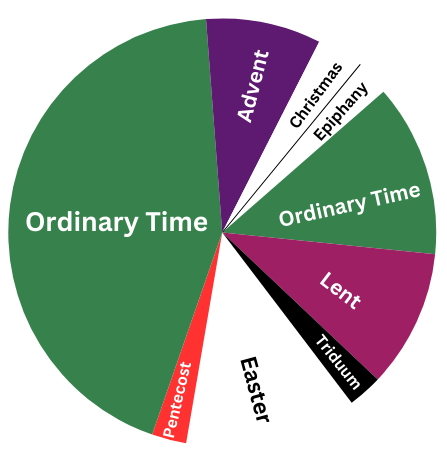Dear Congregation,
I pray that all is well with you as we enjoy cooler temperatures while the majority of the USA is battling extreme cold and snow! I imagine you join me in worrying about relatives and friends up north and praying that they are safe.
I have a little teaching to share with you today about our liturgical calendar. In our Ministry of Church and Spiritual Life meeting last Sunday, it was brought to my attention that some in the congregation would appreciate a “refresher course” on the meaning of the liturgical year and its colors. I thought this short piece from Wikipedia might be helpful, and so I share it with you.
The liturgical cycle divides the year into a series of seasons, each with its own mood, theological emphases, and modes of prayer, which can be signified by different ways of decorating churches, colors of paraments and vestments for clergy, scriptural readings, themes for preaching and even different traditions and practices often observed personally or in the home. In churches that follow the liturgical year, the scripture passages for each Sunday (and even each day of the year in some traditions) are specified in a lectionary.
After the Protestant Reformation, Anglicans and Lutherans continued to follow the lectionary of the Roman Rite. Following a decision of the Second Vatican Council, the Catholic Church revised that lectionary in 1969, adopting a three-year cycle of readings for Sundays and a two-year cycle for weekdays.
Adaptations of the revised Roman Rite lectionary were adopted by Protestants, leading to the publication in 1994 of the Revised Common Lectionary for Sundays and major feasts, which is now used by many Protestant denominations, including also Methodists, United, some Reformed, etc. This has led to a greater awareness of the traditional Christian year among Protestants, especially among mainline denominations.
If we view the church year as a pie, moving clockwise you can see that we are now in the relatively short season of Epiphany. The color for the Feast Day of Epiphany, which was January 6th. is white, while the Sundays after Epiphany are in green as ordinary time.
“Ordinary” comes from the same root as our word “ordinal”, and in this sense means “the counted weeks”. In the Catholic Church and in some Protestant traditions, these are the common weeks which do not belong to a proper season. Wikipedia
We will be in Ordinary Time with its green paraments until Ash Wednesday which is February 14th this year when we enter Lent with its purple paraments. Paraments include the hangings on the pulpit, lectern (if there is one) and the cloth on the Communion Table. The ministerial stoles I wear also are of the same color.
We’re hoping to do much more in the future with decorating in the Sanctuary to carry out the theme of the church season. Please let me know if you’re interested in helping with that.
I hope you found this information informative! I hope to see you in worship this “green” Sunday in person or on Facebook.
God Bless You!
In Christ’s love,
Pastor Candy
click here to view this week's newsletter!
